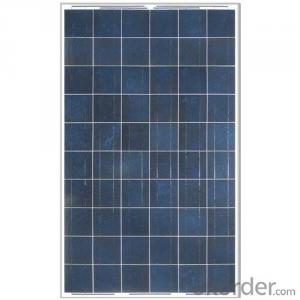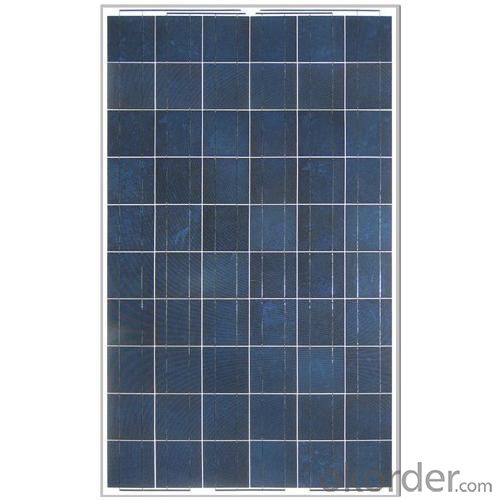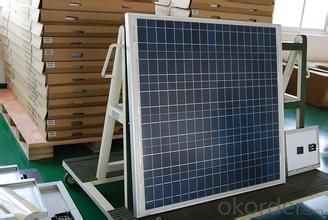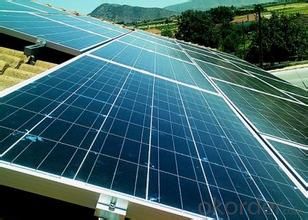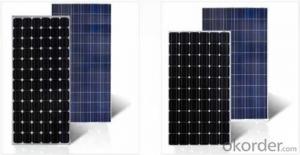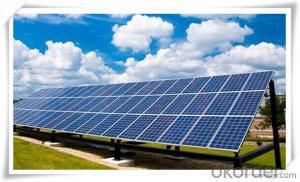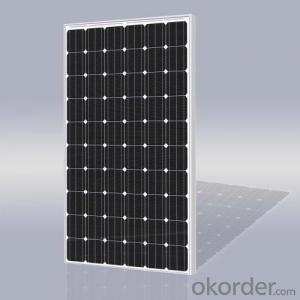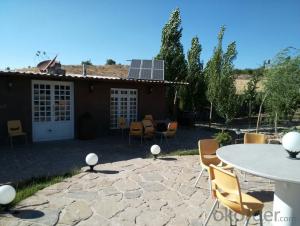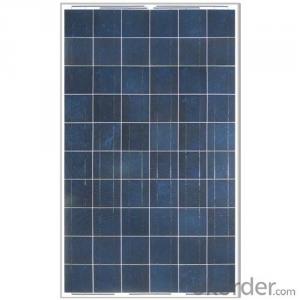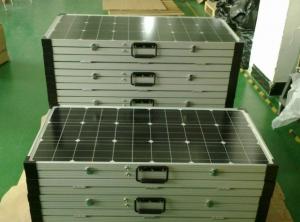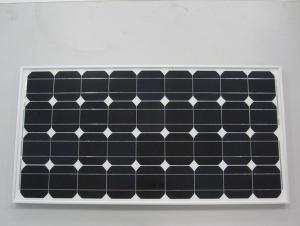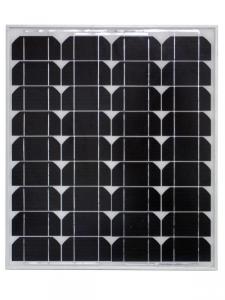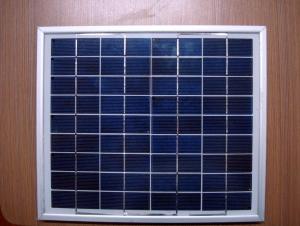Indiana Solar Panels - Poly 260W-300W Solar Panel CE/IEC/TUV/UL Certificate
- Loading Port:
- Shanghai
- Payment Terms:
- TT OR LC
- Min Order Qty:
- 1000 watt
- Supply Capability:
- 100000000 watt/month
OKorder Service Pledge
OKorder Financial Service
You Might Also Like
Quality and Safety of Poly 230W Solar Panel CE/IEC/TUV/UL Certificate
1. Rigorous quality control meets the highest international standards.
2. High-transmissivity low-iron tempered glass, strong aluminium frame.
3. Using UV-resistant silicon.
4. IS09001/14001/CE/TUV/UL
Warranties of Poly 230W Solar Panel CE/IEC/TUV/UL Certificate
1. 10 years limited product warranty
2. 15 years at 90% of the minimal rated power output
3. 25 years at 80% of the minimal rated power output
Technical date of Poly 230W Solar Panel CE/IEC/TUV/UL Certificate :
ITEM NO.: | Poly 156*156 cell ,72pcs . Power range from 260Wp-300Wp | ||||||||
Maximum Power(W) | 260 | 265 | 270 | 275 | 280 | 285 | 290 | 295 | 300 |
Optimum Power Voltage(Vmp) | 34.7 | 34.9 | 35.0 | 35.2 | 35.3 | 35.4 | 35.6 | 35.8 | 36.0 |
Optimum Operatige Current(Imp) | 7.50 | 7.60 | 7.72 | 7.82 | 7.94 | 8.05 | 8.15 | 8.24 | 8.33 |
Open Circuit Voltage(Voc) | 43.5 | 43.6 | 43.7 | 43.8 | 44.0 | 44.1 | 44.3 | 44.5 | 44.8 |
Short Circuit Current(Isc) | 8.21 | 8.31 | 8.40 | 8.48 | 8.58 | 8.67 | 8.75 | 8.82 | 8.90 |
Solar Cell: | 156*156 Poly | ||||||||
Number of Cell(pcs) | 6*12 | ||||||||
Brand Name of Solar Cells | JA Cell, Bluesun Cell | ||||||||
Size of Module(mm) | 1960*992*50 | ||||||||
Caple & Connector Type | Pass the TUV Certificate | ||||||||
Frame(Material Corners,etc.) | Aluminium-alloy | ||||||||
Backing (Brand Type) | TPT | ||||||||
Cell Efficiency for 300W(%) | 15.6% | ||||||||
Weight Per Piece(KG) | 26.35KG | ||||||||
FF (%) | 70-76% | ||||||||
Junction Box Type | Pass the TUV Certificate | ||||||||
Tolerance Wattage(e.g.+/-5%) | ±3%, or 0-3% | ||||||||
Front Glass Thikness(mm) | 3.2 | ||||||||
Temperature Coefficients of Isc(%) | +0.04 | ||||||||
Temperature Coefficients of Voc(%) | -0.38 | ||||||||
Temperature Coefficients of Pm(%) | -0.47 | ||||||||
Temperature Coefficients of Im(%) | +0.04 | ||||||||
Temperature Coefficients of Vm(%) | -0.38 | ||||||||
Temperature Range | -40°C to +85°C | ||||||||
Surface Maximum Load Capacity | 2400Pa | ||||||||
Allowable Hail Load | 23m/s ,7.53g | ||||||||
Bypass Diode Rating(A) | 12 | ||||||||
Warranty | 90% of 10 years,80% of 25 years. | ||||||||
Standard Test Conditions | AM1.5 1000W/ 25 +/-2°C | ||||||||
Packing | carton or pallet | ||||||||
1*20' | 20 Pallets / 250pcs | ||||||||
1*40'STD | 20 Pallets / 500pcs | ||||||||
Diagram of Poly 230W Solar Panel CE/IEC/TUV/UL Certificate
 Diagram of Poly 230W Solar Panel CE/IEC/TUV/UL Certificate
Diagram of Poly 230W Solar Panel CE/IEC/TUV/UL Certificate
Standard production line of Factory
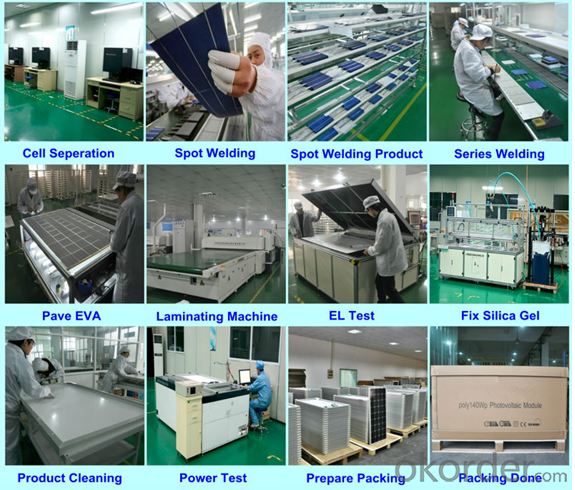
Packaging of Poly 230W Solar Panel CE/IEC/TUV/UL Certificate
u Normally packing: 1pc/2pcs/3pcs/10pcs/25pcs per carton
u Individual packing requirement is acceptable.

Shipping of Poly 230W Solar Panel CE/IEC/TUV/UL Certificate
By Sea | Delivery from Shanghai or Ningbo seaport |
By Air | Departure from Shanghai Pudong Airport |
By Express | Post by DHL, EMS, UPS, TNT. |
FAQ of Poly 230W Solar Panel CE/IEC/TUV/UL Certificate
(1) Can you offer the test report of the module?
Sure. All the solar modules must pass necessary tests including EL test and ultra-red test and other visual test of the apperance, and the test report presents all the detailed data of the modules.
(2) How to confirm about the quantity and the type of solar module?
It depends on the solar system where you want to put into use the solar modules. We have experienced engineers to design for your order and you need to give more information to fix the details.
- Q: My mom's house has some solar power panels on the top of her house but they are not connected to anything. They don't even have wires or anything like that. Does anyone know how to connect and make solar panels work? Thank You
- They may be connected and running, but you just can't see the cables because they are concealed. Of they may not even be electric. They may be solar water heaters that have water lines running inside a black box. Did your mom purchase the house with them on there? If so, can she contact the previous owner to learn who installed them and why? In the absence of any meaningful information, I would suggest that you call a solar company in your area and have them come out to tell you what it is that you have.
- Q: I have a solar energy panel that works in every room except mine. I have those severely bright, energy efficient bulbs and it doesn't work at all.What do I do? Is the bulbs really causing this? Why?
- It's giving off a good chunk of its energy as light in the range 800-00nm which the solar panel can efficiently harvest into electricity. As a lightbulb though, this energy is being wasted because you can't see light of those wavelengths!
- Q: I want to build a solar panel
- Did okorder / . This will absolutely save yourself!
- Q: Are solar panels durable?
- Yes, solar panels are generally durable. They are designed to withstand harsh weather conditions, such as rain, snow, and wind. Additionally, they have a long lifespan, typically ranging from 25 to 30 years. However, the durability may vary depending on the quality of the panels and the installation process.
- Q: I have to get a lot of information on how solar panels are developed and distributed in America because I have to do two pages on this. Please help me get information in this I really need it!! Thankss...
- The first link below is one of the best sites for recent news about solar panels. You should be able to find stories about solar panels under development today. A little bit of the history: Solar panels have been around for about 50 years now. They were first used to power spacecraft. Solar power for domestic use started to develop rapidly in the 970's during the first oil crisis, but as energy prices fell in the 980's solar development slowed. Most of the large solar panel makers were purchased by large oil companies who seemed not to be too interested in solar. In the late 990's as concerns about both Peak Oil and Global Warming grew there was renewed interest in solar power and a number of new companies were started to develop new kinds of solar panels. Many of these new companies have grown larger than the older solar companies still owned by big oil companies. Over the last 7 years or so growth in the solar market has been explosive with a compound growth rate of almost 40% per year. In 2005 the solar industry for the first time started to consume more silicon than all other electronic industries combined resulting in a world wide silicon shortage that is still with use. New silicon refineries are coming on line and the shortage is expected to diminish by 2008 or 2009. Check out the two links below. They will help you a lot.
- Q: I have a solar panel i got for free and I don't know what to do with it. Its kinda big at about 20x 0and it puts our 2 VOC / .23 ISC. I don't know of anything that I could use it for. Its too big to say charge a phone or ipod....any suggestions??
- Hey AJ, Tom is quite right, a panel that size is a great trickle charger at .2 amps. If you have a good sized 2 volt battery, like from a truck, or for a boat trolling motor (it should be at least 60 amp hours) you can hook it to the battery and it will charge it slowly anytime the sun shines. Don't worry about the voltage, most 2 volt nominal volt panels are wired for 8 - 9 volts, and if you hook them to a battery, the panel voltage comes right down to the batteries charging curve voltage anyway, they are designed for that. What you do need is a diode. A diode is an electrical check valve, allowing current to flow in one direction, but not the other. This will prevent the battery from discharging through the panel at night. Many panels today come with diodes inside the junction box on the back of the panel. If yours does not have any, go to Radio Shack, look for a 6 amp silicone diode, usually around75 cents. Put it in series between the panel and the battery, then, while you have a voltmeter hooked to the battery, connect the panel/diode to the battery and see if the voltage goes up slightly. If it does, you're all set. If not, turn the diode around and try it again. It has to be connected into the circuit the correct direction. Many people will state that you need a charge controller, but this is not necessary if your panels max current, ISC is less than 2% of your batterys amp hour capacity. In your case, if you have a 60 AH or larger battery, skip the controller. There is a great discussion about this in Richard Perez's book, I will list it below. If you want to learn more about these devices, there is a great magazine that gets into the nuts and bolts of renewable energy, it's called Home Power Magazine, the link is below. We started by hooking a slightly larger panel to some golf cart batteries 2 years ago, reading that magazine and going to some energy fairs. Today our home is completely powered by the wind and sun. Check it out sometime. Take care, Rudydoo
- Q: Are solar panels suitable for all climates?
- Solar panels are suitable for a wide range of climates, but their efficiency may vary depending on the amount of sunlight available. While they can still generate electricity in cloudy or colder regions, they perform best in areas with high solar insolation and minimal shading. Advances in technology have made solar panels more adaptable, allowing them to be utilized effectively in various climates around the world.
- Q: Can solar panels be installed on a convention center or event venue?
- Yes, solar panels can be installed on a convention center or event venue. In fact, many convention centers and event venues are increasingly adopting solar energy solutions to reduce their carbon footprint and lower energy costs. The large roof spaces available in these venues often make them ideal for solar panel installations, allowing them to generate clean and renewable energy.
- Q: I was just wondering what the minimum and maximm charging voltage and ampere is for li ion batteries. If i connect a solar panel, which only gets enough sunshine to generate voltage, will that still charge the battery, or would i have to series connect solar panels until they together reach 3,7volt?
- One lithium cell requires 4.2V to obtain its full charge, Never exceed 4.2V ! Output from solar panel if below 3.7V , nothing charge to lithium. Total charging time until the cell is full depending on the AH rate of cell and the charging current that solar panel can be provided. Suppose cell is rate 5AH, and the charging current from solar panel under full sun shine can maintain 0.5A ( use solar panel short circuit current rate from its specification as a reference ) , hence, 0 hours is enough. And be sure the solar panel can maintain 4.2V output at 0.5A . Remember, over charge lithium cell one time might reduce its life into half . Therefore, let the solar panel output passing through a precision regulator to maintain output is 4.2V is the best way, because, as cell reaches 4.2V , no more charging current is forced into cell ( automatic stop charging ). If you do not have the knowledge to make this simple variable voltage regulator with LM37K ( if you choose this way, buy solar panel output has at least 2V) , you may choose to do it manually by install a current meter and a variable resistor in series between the panel output to cell. By adjust the value of resistor, charging current can be controlled ( if you choose this way, buy solar panel output has as less as 6V ). Count the charging time with a clock and adjust the charging current from time to time to maintain 0.5A .
- Q: Can solar panels be installed on mountain huts or lodges?
- Yes, solar panels can be installed on mountain huts or lodges. In fact, mountain huts and lodges are often great locations for solar panel installations due to their high elevation and exposure to sunlight. Solar panels can provide a reliable and sustainable source of electricity in remote mountainous areas, reducing reliance on traditional power sources and minimizing environmental impact.
Send your message to us
Indiana Solar Panels - Poly 260W-300W Solar Panel CE/IEC/TUV/UL Certificate
- Loading Port:
- Shanghai
- Payment Terms:
- TT OR LC
- Min Order Qty:
- 1000 watt
- Supply Capability:
- 100000000 watt/month
OKorder Service Pledge
OKorder Financial Service
Similar products
Hot products
Hot Searches
Related keywords
